Can Any War Be “Just”? Vietnam War in Rare Photos.

March 29th is Vietnam War Veterans Day. It is also designated for official commemoration of the 50th Anniversary of the Vietnam War. On March 29th, 1973, the last U.S. troops left Vietnam, ending American military presence in the region that lasted since its initiation under President Kennedy in 1961 and surge under President Lyndon B. Johnson in 1964.
Over 2.7 million Americans served in the Vietnam War, almost 10% of their generation. During the war, 58,000 Americans were killed and 1.3 million Vietnamese (including over half a million civilians). 61% of American men killed were 21 or younger. The war was one of the most divisive periods of American history and continues to affect the American psyche every time its foreign policy approaches military intervention.

After receiving a fresh supply of ammunition and water flown in by helicopter, men of the US 173rd Airborne Brigade continue on a jungle ‘Search and Destroy’ patrol in Phuc Tuy Province, Vietnam, June 1966. An armored personnel carrier provides security on the landing zone in the background. (Photo by Hulton Archive/Getty Images)
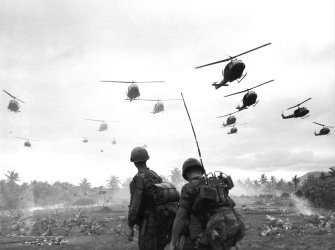
The second wave of combat helicopters of the 1st Air Cavalry Division fly over an RTO and his commander on an isolated landing zone during Operation Pershing, a search and destroy mission on the Bong Son Plain and An Lao Valley of South Vietnam, during the Vietnam War. The two American soldiers are waiting for the second wave to come in. (Photo by Patrick Christain/Getty Images)

Vietnamese refugees returning to Hue. (Photo by Terry Fincher/Getty Images)
WHAT IS A “JUST” WAR?
Just war theory” is a doctrine that goes all the way back to Saint Augustine and stipulates that certain criteria exist that may make war morally justifiable. These include ‘the right to go to war’ (jus ad bellum) and ‘right conduct in war’ (jus in bello). The first one speaks to the morality of entering a war and the second one about conduct within a war.
What would make reasons for going to war morally acceptable? There needs to be a just cause, which doesn’t mean recapturing things or punishing bad people, but rather innocent life must be in imminent danger and intervention must be made to protect life. Essentially, it should be a war of self-defense. A “just” war should be waged as a last resort, when all peaceful alternatives have been exhausted, while conducted by a competent authority (government) which has a strong probability of success.

American marines with their pet dog in Vietnam. (Photo by Express Newspapers/Getty Images)

An American marine weeping in Vietnam. (Photo by Terry Fincher/Getty Images)

February 1970: Lance Corporal Charles C. Sead of Portsmouth, Ohio, carries an elderly Vietnamese woman too old to keep up with the patrol in the Arizona Territory, 22 miles southwest of Da Nang, Vietnam. (Photo by Keystone/Getty Images)
HOW TO BE NICE IN A “JUST” WAR
In a “just” war, once the war is waged, the combatants are to direct their actions towards enemy combatants and not civilians, without causing excess harm. Prisoners are not to be tortured and all military actions are to be taken from the principle of necessity and proportionality.
Of course, this is a fairly philosophical doctrine and wars do not fit into neat principles. Still, the doctrine is often invoked as a public-facing explanation for why a war is undertaken. You can see traces of it in the justification for the Vietnam War and the American wars that come since. After all, we went to Iraq essentially in self-defense, fearful of Saddam’s WMDs.

11th April 1968: US soldiers, one wounded and being carried by a colleague, walking down Hill Timothy, during the conflict in Vietnam. (Photo by Terry Fincher/Express/Getty Images)
WAS THE WAR IN VIETNAM A “JUST” WAR?
The official reasons for US involvement in Vietnam were based on the “domino theory” that posited a domino effect of countries in Southeast Asia all falling under communist control if one country was to be taken over. Thus, American support of the South Vietnamese government against the communists of North Vietnam led to increasing entanglement. But does this fear of a communist takeover of a region constitutes a legitimate self-defense argument? It’s hard to argue that U.S. was directly attacked or was going to be attacked by anyone in the region.
And was the Vietnam War conducted justly once it began? The U.S. Army was involved in a number of horrifying massacres during the war, most notorious of which being the My Lai Massacre, when on March 16, 1968, U.S. Army soldiers killed between 347 and 504 unarmed civilians. A large number of these were women and children. The moral fog of war covered the American use of herbicide and defoliants like Agent Orange, which was sprayed across Vietnamese jungles in an attempt to deprive the Viet Cong of food and cover. Among many ill effects, exposure to the chemicals led to hundreds of thousands of birth defects in Vietnamese children.
As hard as it is to consider the Vietnam War a “just” war, can any war truly make such a claim?

A US Special Forces soldier pulls a dead North Vietnamese soldier from a hole outside the Special Forces outpost, on June 21, 1969, during the Ben Het battle, in Dak Seang area. (Photo credit should read -/AFP/Getty Images)

16th January 1967: Two US Marine sergeants getting a supply of Ace of Spades cards, known as the ‘death cards’ which the reconnaissance forces leave as a warning to the Viet Cong, before going on patrol in enemy territory. (Photo by Keystone/Getty Images)

6th July 1970: Two American marines carrying a young Vietnamese refugee in a basket during the evacuation of a village near Da Nang. (Photo by Keystone/Getty Images)

D.R. Howe treats the wounds of Private First Class D.A. Crum, ‘H’ Company, 2nd Battalion, Fifth Marine Regiment, During Operation Hue City in Vietnam 06 February, 1968 (Photo credit: NATIONAL ARCHIVES/AFP/Getty Images)

An American Marine gives a North Vietnamese prisoner of war a drink of water during the Vietnam War. The prisoners, captured by a reconnaissance patrol, wear labels with details of time and place of capture. (Photo by Keystone/Getty Images)

Two GI’s admiring the American actress Raquel Welch during a visit to Vietnam. (Photo by Keystone/Getty Images).
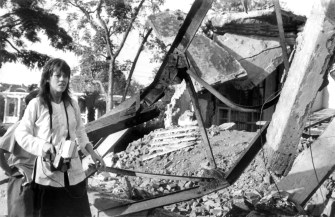
US actress and peace activist Jane Fonda, holding a camera, visits 25 July 1972 a Hanoi site bombed by US airplanes. Fonda’s trip to North Vietnam was part of her protest campaign against the US involvement in the Vietnam war. US bombers, including B-52 strato-fortresses, started to bomb the North Vietnamese capital and its port Haiphong in April 1972. (Photo credit: AFP/Getty Images)

Viet Cong soldiers moving forward under covering fire from a heavy machine gun during the Vietnam War, circa 1968. (Photo by Three Lions/Hulton Archive/Getty Images)

A Vietnamese civilian with a gun pointed at the side of her head. (Photo by Keystone/Getty Images)

US riflemen from the 173rd Airborne Brigade charge toward Viet Cong positions, holding machine guns in a wooded area of War Zone D during the Vietnam War, March 21, 1967. (Photo by U.S. Army/Getty Images)

circa 1967: A little girl in Vietnam looking over the shoulder of the soldier who is carrying her. (Photo by J. Dezort/Keystone/Getty Images)

4th November 1968: US marines on patrol in a jungle during the Vietnam war. (Photo by Terry Fincher/Express/Getty Images)
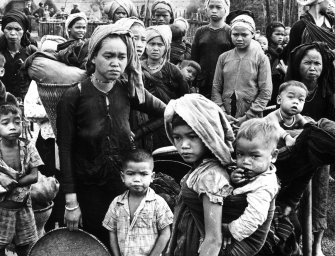
circa 1970: A group of Vietnamese refugees. (Photo by Three Lions/Getty Images)
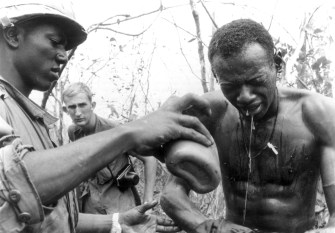
March 1967: Moses Green, a medic in the 173rd Airborne Brigade, pouring water on Staff Sergeant Melvin Gaines who has just emerged after several hours searching a network of Vietcong tunnels. (Photo by Keystone/Getty Images)

Blindfolded prisoners are taken away by South Vietnamese troops during the Vietnam War, 12th April 1972. (Photo by Ian Brodie/Daily Express/Hulton Archive/Getty Images)

A US soldier carrying a wounded refugee to safety during the war in Vietnam. (Photo by Terry Fincher/Getty Images)

An American soldier pushing his combat gear across a river in Hau Nghia province, Vietnam. (Photo by Keystone/Getty Images)
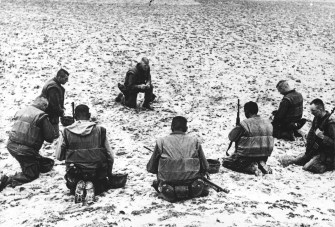
22nd March 1966: US marines carrying rifles and wearing anti-fragmentation jackets kneel in prayer before moving on to battle stations at Da Nang in South Vietnam. (Photo by Keystone/Getty Images)

08 February 1966: F105 Thunderchief of the US Army bombing military and strategic targets in north Vietnam during the Vietnam War. (Photo credit should read STF/AFP/Getty Images)

Senator John Mccain Is Pulled Out Of A Hanoi Lake By North Vietnamese Army Soldiers And Civilians on October 26, 1967 In Hanoi, North Vietnam. Mccain’s A-4E Skyhawk Was Shot Down By A Surface-To-Air Missile. Mccain Broke Both Arms And His Right Knee Upon Ejection And Lost Consciousness Until He Hit The Water. (Photo By Getty Images)

Armed Viet-cong guerillas carry ammunition on elephant back through a South Vietnam high plateau forest 13 November 1969 during the Vietnam war. (Photo credit: AFP/AFP/Getty Images)

A human skull keeps watch over US soldiers encamped in the Vietnamese jungle during the Vietnam War. (Photo by Terry Fincher/Getty Images)

A soldier of the US Seventh Marines carrying a little puppy in his pocket after rescuing it during an operation south west of Da Nang in Vietnam. (Photo by Keystone/Getty Images)
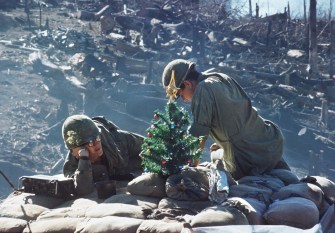
Picture taken 25 December of soldiers taking rest close to a small Xmas tree, on their position at the Hill 875 near Dakto, few days after the North Vietnamese Army made a massive assault. (Photo credit should read CORR/AFP/Getty Images)

An American soldier takes a shower during the Battle of Snuol, Cambodia, 9th May 1970. The battle was part of the joint South Vietnamese and U.S Cambodian Incursion during the Vietnam War. (Photo by Express/Hulton Archive/Getty Images)

10 June 1972: Young Viet Cong women carry the ammunition to the front in Quang Tri province, south Vietnam. (Photo credit should read VAN BANG/AFP/Getty Images)

US troops take cover from the Vietcong in a trench on Hill Timothy, during the Vietnam War. (Photo by Terry Fincher/Getty Images)

Vietnamese ‘boat people’ refugees huddle together on a tarp as they are airlifted out of the sea during the Vietnam War, 1960s. (Photo by Express Newspapers/Getty Images)





